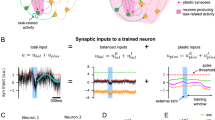Abstract
A neural network with realistically modeled, spiking neurons is proposed to model ensemble operations of directionally tuned neurons in the motor cortex. The model reproduces well directional operations previously identified experimentally, including the prediction of the direction of an upcoming movement in reaching tasks and the rotation of the neuronal population vector in a directional transformation task.
Similar content being viewed by others
References
Bush PC, Sejnowski TJ (1991) Simulations of a reconstructed cerebellar purkinje cell based on simplified channel kinetics. Neural Comp 3:321–332
Caminiti R, Johnson PB, Galli C, Ferraina S, Burnod Y, Urbano A (1991) Making arm movements within different parts of space: the premotor and motor cortical representation of a coordinate system for reaching at visual targets. J Neurosci 11:1182–1197
Eisenman LN, Keifer J, Houk JC (1991) Positive feedback in the cerebro-cerebellar recurrent network may explain rotation of population vectors. In: Eeeckman F (ed) Analysis and modeling of neural systems. Kluwer, Norwell, MA, pp 371–376
Ekeberg O, Wallen P. Lansner A, Traven H, Brodin L, Grillner S (1991) A computer based model for realistic simulations of neural networks. I. The single neuron and synaptic interaction. Biol Cybern 65:81–90
Fortier PA, Kalaska JF, Smith AM (1989) Cerebellar neuronal activity related to whole-arm reaching movements in the monkey. J Neurophysiol 62:198–211
Georgopoulos AP, Kalaska JF, Caminiti R, Massey JT (1982) On the relation between the direction of two-dimensional arm movements and cell discharge in primate motor cortex. J Neurosci 2:1527–1537
Georgopoulos AP, Caminiti R, Kalaska JF, Massey JT (1983) Spatial coding of movement: a hypothesis concerning the coding of movement by motor cortical populations. Exp Brain Res [Suppl]7:327–336
Georgopoulos AP, Kalaska JF, Crutcher MD, Caminiti R, Massey JT (1984) The representation of movement direction in the motor cortex: Single cell and population studies. In: Edelman GM, Cowan WM, Gall WE (eds) Dynamic aspects of neocortical function. Wiley, New York, pp 501–524
Georgopoulos AP, Schwartz AB, Kettner RE (1986) Neuronal population coding of movement direction. Science 233:1416–1419
Georgopoulos AP, Kettner RE, Schwartz AB (1988) Primate motor cortex and free arm movement to visual targets in three-dimensional space. II. Coding of the direction of movement by a neuronal population. J Neurosci 8:2928–2937
Georgopoulos AP, Crutcher MD, Schwartz AB (1989a) Cognitive spatial motor processes. 3. Motor cortical prediction of movement direction during an instructed delay period. Exp Brain Res 75:183–194
Georgopoulos AP, Lurito JT, Petrides M, Schwartz AB, Massey JT (1989b) Mental rotation of the neuronal population vector. Science 243:234–236
Georgopoulos AP, Taira M, Lukashin AV (1993) Cognitive neurophysiology of the motor cortex. Science 260:47–52
Harris-Warrick RM, Marder E (1991) Modulation of neural networks for behavior. Annu Rev Neurosci 14:39–57
Hodgkin AL, Huxley AF (1952) A quantitative description of membrane current and its application to conduction and excitation in nerve. J Physiol (Lond) 117:500–544
Kalaska JF, Caminiti R, Georgopoulos AP (1983) Cortical mechanisms related to the direction of two-dimensional arm movements: relations in parietal area 5 and comparison with motor cortex. Exp Brain Res 51:247–260
Koch C, Segev I (eds) (1989) Methods in neural modelling: from synapses to neurons. MIT Press, Cambridge, Mass
Lukashin AV (1994) A learned neural network that simulates properties of the neuronal population vector. Biol Cybern 62:377–382
Lukashin AV, Georgopoulos AP (1993) A dynamical neural network model for motor cortical activity during movement: population coding of movement trajectories. Biol Cybern 69:517–524
Lukashin AV, Georgopoulos AP (1994) A neural network for coding of trajectories by time series of neuronal population vectors. Neural Comp 6:19–28
Lurito JT, Georgakopoulos T, Georgopoulos AP (1991) Cognitive spatial-motor processes. 7. The making of movements at an angle from stimulus direction: studies of motor cortical activity at the single cell and population levels. Exp Brain Res 87:562–580
Schwartz AB (1993) Motor cortical activity during drawing movements: population representation during sinusoid tracing. J Neurohysiol 70:28–36
Smyrnis N, Taira M, Ashe J, Georgopoulos AP (1992) Motor cortical activity in a memorized delay task. Exp Brain Res 92:139–151
Tononi G, Sporns O, Edelman GM (1992) Reentry and the problem of integrating multiple cortical areas: simulation of dynamic integration in the visual system. Cerebral Cortex 2:310–335
Author information
Authors and Affiliations
Rights and permissions
About this article
Cite this article
Lukashin, A.V., Georgopoulos, A.P. Directional operations in the motor cortex modeled by a neural network of spiking neurons. Biol. Cybern. 71, 79–85 (1994). https://doi.org/10.1007/BF00198913
Received:
Accepted:
Issue Date:
DOI: https://doi.org/10.1007/BF00198913




